
 Food: plastic or real, and package presentation
Food: plastic or real, and package presentation
















Entries and images from Semester at Sea voyages ... around the world with Judy. Current posts from Fall 2015. Prior posts from Fall 2013, Spring 2013 and Fall 2010

 Food: plastic or real, and package presentation
Food: plastic or real, and package presentation




















 Every visitor to Hong Kong takes the breathtaking tram steeply up Victoria Peak for the views of the harbor, Kowloon Island, and the New Territories (which were new 100 years ag0.)
Every visitor to Hong Kong takes the breathtaking tram steeply up Victoria Peak for the views of the harbor, Kowloon Island, and the New Territories (which were new 100 years ag0.)



Bright lights, skyscrapers, terrible traffic from all the automobiles, overhead expressways winding through the daring architecture, and evidence everywhere of the rising middle class.

Our 3-day Tour Guide Lucia works for a national (governmental) agency. She is smart, hip, enthusiastic, and always 'says the right thing.' These tour guides are very knowledgable, having to pass a strident exam every 3 years with the real possibility of being permanently discharged if they miss 10 points from either incorrect answers or complaints. One Tour Guide has bought the license to have a second child ($15,000) and another Guide is contemplating buying and paying taxes for a Mini Cooper car ($75,000).
A Pepsi salesman on The Great Wall.
On The Wall we actually encountered traditional peasant class Chinese with broken English and, generally, big smiles!


 Looking back mid-way through the first morning: we began our hike way over there by the road along one of the un-reconstructed parts of the Wall. We walked single file because sometimes the trail was only 14"-16" wide with steep slopes or drop-offs on one or both sides.
Looking back mid-way through the first morning: we began our hike way over there by the road along one of the un-reconstructed parts of the Wall. We walked single file because sometimes the trail was only 14"-16" wide with steep slopes or drop-offs on one or both sides. 












 Beijing: listed at 15 million but the Chinese tell us just under 20 million people, busy, clean and orderly, many parks, skyscrapers and more skyscrapers, traditional China enclaves nestled into contemporary China, tourists, Tiananman Square, the Foridden City, 60 km access to The Great Wall. Traffic congestion is bad so every day certain cars may not drive based on the last number of the license tag. Just about every photo taken shows a layer of pollution in the sky.
Beijing: listed at 15 million but the Chinese tell us just under 20 million people, busy, clean and orderly, many parks, skyscrapers and more skyscrapers, traditional China enclaves nestled into contemporary China, tourists, Tiananman Square, the Foridden City, 60 km access to The Great Wall. Traffic congestion is bad so every day certain cars may not drive based on the last number of the license tag. Just about every photo taken shows a layer of pollution in the sky.